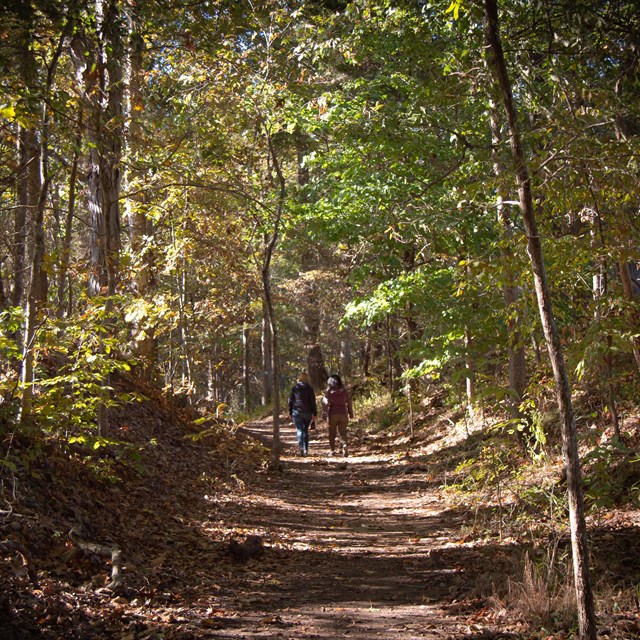Part of a series of articles titled Transportation During the Cherokee Removal 1837 - 1839.
Article
The Tuscumbia, Courtland & Decatur Railroad: Transportation During the Cherokee Removal 1837 - 1839
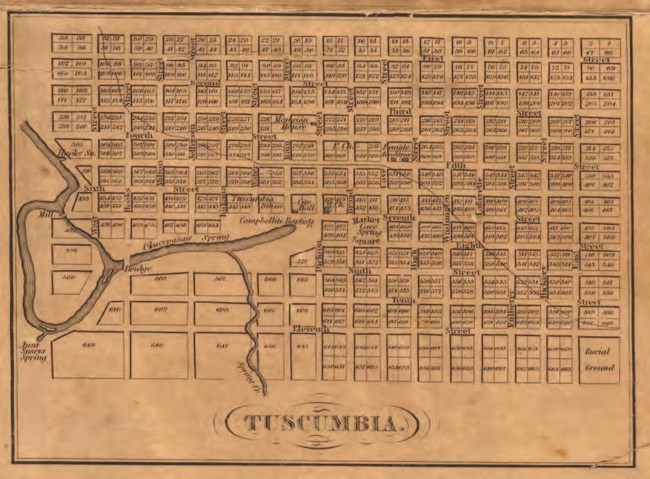
Map/ David Rumsey Map Collection, davidrumsey.com.
The Tuscumbia, Courtland & Decatur Railroad was among the earliest railroads in the United States and was the first railroad located west of the Allegheny Mountains. Its formation was born out of the economic need to bring goods efficiently into the local economy of northeastern Alabama and to transport cotton and other commodities year-round, by avoiding the dangerous Muscle Shoals area of the Tennessee River. Prior to the development of the railroad, the most efficient way to move goods across northeastern Alabama was by the Tennessee River, but it was only a seasonal operation, at best. Islands, low-lying shoals of jagged rocks, intense rapids, and low water levels made the Muscle Shoals area impassable and halted economic activity on the river for nine to 10 months of the year, on average.
Seeing an opportunity to benefit economically from the increasing amount of steamboat travel on the Tennessee River, Tuscumbia merchants built large warehouses and a landing at the confluence of Spring Creek and the Tennessee River, which became known as Tuscumbia Landing. This location presented a major problem, though, as the city of Tuscumbia was located two miles from this new landing, and goods, in large quantities, needed to be transported from the city to the landing on a regular basis and in a timely manner.
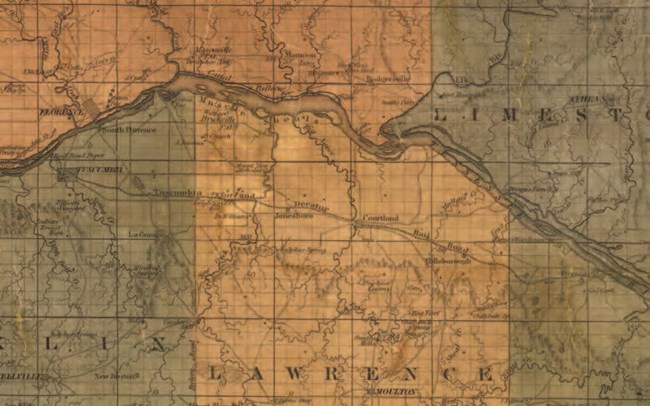
Map/David Rumsey Map Collection, davidrumsey.com
On January 16, 1830, the Tuscumbia Railway Company was incorporated to build a railroad from the town of Tuscumbia to the Tennessee River. Work on the 2-mile railroad started in June 1831 and was completed a year later, at a cost of $4,523.85 per mile. The railroad proved a success, and even before its completion discussions were underway to expand the railroad’s length to serve as a year-round alternate transportation route around the dangerous Muscle Shoals.
In January 1832, the state legislature granted a charter for the Tuscumbia, Courtland & Decatur Railroad for a 43-mile expansion of the railroad from Tuscumbia to Decatur. Work progressed swiftly on the railroad through the hard work of enslaved African Americans. Before the end of 1834, the entire 43-mile section of railroad between Tuscumbia and Decatur was completed and ready for use with depots located in Tuscumbia, Leighton (Crossroads), Jonesborough (Town Creek), Courtland, Hillsborough, and Fennell’s Turnout (Trinity).

engine built in 1830 by Edward Bury.
Image/ “Edward Bury and Co: Liverpool,” Grace’s Guide to British Industrial History, https://www.gracesguide.co.uk.
Several years after the completion of the railroad, approximately 2,000 Cherokee, and some Creek, traveled in three detachments on the newly constructed railroad for a leg of their journey to Indian Territory. During this time, the railroad utilized freight and passenger cars pulled by four steam locomotives, named Fulton, Pennsylvania, Comet, and Triumph. The first two locomotives acquired for the railroad were the Fulton and the Pennsylvania. The Fulton was a 0-4-0-type engine manufactured by Edward Bury of Liverpool, England, at a cost of $4,915.04. The Pennsylvania was initially constructed by British manufacturer Robert Stephenson and Company of Newcastle-upon-Tyne but purchased second hand from the Philadelphia, Germantown & Norristown Railroad Company for $5,880.37. Another 0-4-0-type engine, named the Comet, was ordered from the West Point Foundry in New York and cost $7,959.82. This engine was the first recorded iron-frame, American-made locomotive. The locomotive engine Triumph was a 4-2-0-type engine made by W. M. Baldwin of Philadelphia and cost $7,091.66. It was placed on the tracks on June 1, 1836.
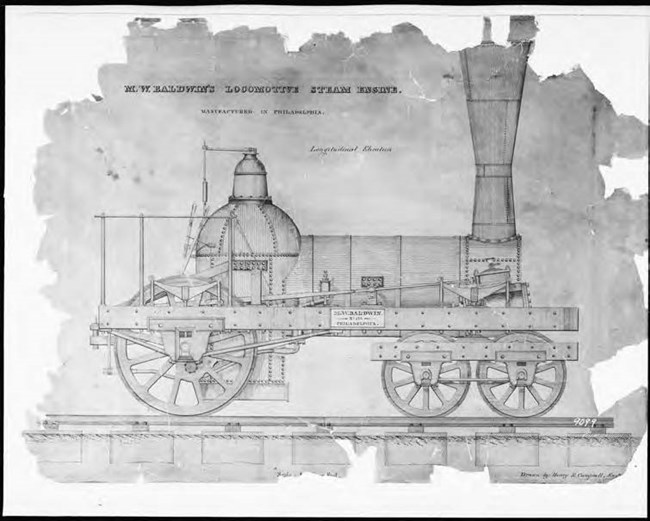
Image/ Courtesy of the Baldwin Negatives Collection, Railroad Museum of Pennsylvania, PHMC.
These four steam locomotives hauled passenger or “pleasure” cars, and small, flat freight cars, known as “burden” cars. Very little information is known about the railroad’s passenger cars due to the scarcity of existing records from the railroad. Mrs. J. M. Clark, a native of Moulton, Alabama, whose father worked on the railroad, described the passenger cars as “exaggerated stage coach[es],” which is consistent with trends at the time. The earliest passenger cars utilized on American railroads were, in fact, open-air carriages, similar in design to stagecoaches.
These early passenger cars were mostly built by established carriage-makers, who built what they already knew, constructing bodies identical to those used for road coaches. These stagecoach-style bodies were then mounted on wheels, appropriate for use on the railroad, that were usually manufactured by a separate entity. Tuscumbia carriage-maker Henry Williams, for example, manufactured at least one of the passenger cars for the railroad. Williams was manufacturing and selling carriages from his shop in Tuscumbia as early as the mid-1820s. He was commissioned to build a passenger car for the Tuscumbia, Courtland & Decatur Railroad in 1833. Four years later, he partnered with Wilson Northcross. In addition to offering repair work, Williams and Northcross made harnesses and sold a variety of both new and used vehicles, including barouches, buggies, mail coaches, and passenger coaches.
On March 7, 1837, the first of three Cherokee detachments, consisting of approximately 466 individuals, arrived in Decatur. As a crowd of spectators looked on, the following morning the Cherokee began boarding the first of two trains to take them to Tuscumbia. Unfortunately, this next leg of the journey did not go as planned. About half of the detachment boarded the first train to Tuscumbia at about 8 a.m. and began their journey. The second locomotive was scheduled to arrive at about 1 p.m. By sunset, the locomotive still had not arrived, and the Cherokee were becoming increasingly cold and uncomfortable. As a result, they spent the night in a warehouse owned by the railroad, and their departure was postponed until the following morning.
The second detachment of Cherokee to use the railroad for a leg of its journey—
a group of 600–800 individuals—arrived in Decatur on June 9, 1838, and boarded approximately 32 rail cars hauled by two separate trains the following morning. The train cars were reported to be “necessarily crowded” because no other train cars could be obtained for “want of power in the Locomotive Engines.”
U.S. Army Lt. Robert H. K. Whiteley led the third detachment that used the railroad for a leg of its journey. On June 21, the detachment reached Decatur and boarded two trains for Tuscumbia. The train ride was not without incident, though One mile from Tuscumbia, Whiteley reported, a Cherokee man named Chicken, who was on the second train, “lost his hat[, and] jumped off the car to obtain it.” He was killed in the process.
“From 3 Oclock til Sun Set the Indians continued setting upon the open Carrs [sic], waiting the arrival of the Locomotive, the weather having become very cold, their condition was quite uncomfortable[,] at length the order was given that the train would not start til morning. The Indians were immediately and anxiously engaged in selecting their bedding for the night; before they accomplished this darkness closed in upon them… The train of Carrs [sic] from the West were momentarily expected, and the Indians were afraid to lie down for fear of being run over.”
- Dr. Clark Lillybridge, March 8, 1837
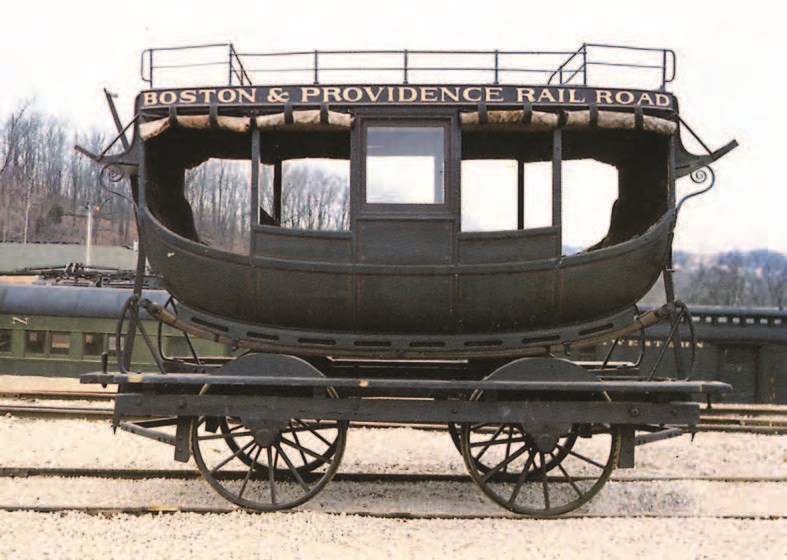
Image/Courtesy of The National Museum of Transportation, St. Louis, Missouri
“[The Cherokees’] appearance, in connection with the locomotive and its train, was not more attractive to the spectators, then did the engine and cars seem to be to the Indians. Many of them could be seen examining, with their peculiar inquisitive silence and gravity, this great enigma to them, while others, apparently uninterested and thoughtless, amused themselves with an old fiddle or sat motionless, gazing at those around.”
- March 15, 1837, reprinted from the American Sentinel in the Pittsburgh Gazette
The invention of the steamboat and railroads, along with vast improvements in the construction, design, and maintenance of roads and turnpikes, marked the beginning of a transportation revolution in the United States during the early 1800s. The Cherokee removal occurred as this revolution began to unfold. While the Cherokee utilized these transformative modes of transportation during their forced removal, it is important to remember that the majority traveled by foot on roads over rough terrain.
This publication was made possible by the Cooperative Ecosystem Studies Unit (CESU) Task Agreement P18AC01316 with National Trails– National Park Service and the Center for Historic Preservation at Middle Tennessee State University.
Read the Full Report
Last updated: December 21, 2021

